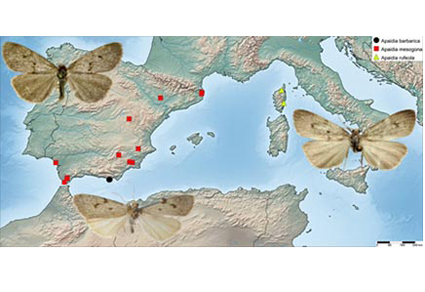Abstract
The genus Apaidia Hampson, 1900 is a relict Western Mediterranean genus in the South-western part of Europe and the North-western areas of the Mediterranean Africa comprising so far three species, Apaidia rufeola (Rambur, 1832), Apaidia mesogona (Godart, [1824]) and Apaidia barbarica Legrand, 1939. According to the examined material, COI mitochondrial DNA sequences and adult morphology integration supports the existence of three main lineages of Apaidia with sequence divergence rates of approximately 4.5%, which are within the range reported for other well-defined insect species. In addition, we recovered three different BINS, suggesting the presence of different species with unique and specific identifier for A. mesogona (AEC6797), A. rufeola (AEI9539), and the Iberian-Balearic A. barbarica (AEI9540). This study contributes to a better understanding of the taxonomy of the genus Apaidia and challenges future revision of this genus in Northern Africa, as well as the presence of the Apaidia species in Western Mediterranean islands and populations located in Italy.
References
- Durante, M.A. & Panzera, S. (1998) Apaidia barbarica messapia n. ssp. dal Salento (Italia meridionale) (Lepidoptera, Arctiidae, Lithosiinae). Lambillionea, 98, 190–196.
- deWaard, J.R., Ivanova, N.V., Hajibabaei, M. & Hebert, P.D.N. (2008) Assembling DNA barcodes: Analytical Protocols. In: Martin, C. (Ed.), Methods in Molecular Biology: Environmental Genetics. Humana Press, Totowa, New Jersey, pp. 275–293. https://doi.org/10.1007/978-1-59745-548-0_15
- Fibiger, M. (1997) Noctuidae Europaeae. Vol. 3. Noctuinae III. Entomological Press, Sorø, 418 pp.
- Gastón, J., Morente-Benítez, F.J. & Redondo, V. (2013) Presencia en la península Ibérica de Apaidia barbarica Legrand, 1939 y revisión de su categoría como especie válida (Lepidoptera: Erebidae). Boletín de la Sociedad Entomológica Aragonesa, 52, 219–222.
- Godart, J.-B. (1822–[1824]) Histoire naturelle des lépidoptères ou papillons de France. Vol. 4. Crevot, París, 424 pp. https://doi.org/10.5962/bhl.title.9259
- Hampson, G.F. (1900) Catalogue of the Lepidoptera Phalaenae in the British Museum, Vol. 2. Arctiadae (Nolinae, Lithosianae). Trustees of the British Museum, London, 589 pp.
- Hausmann, A., Haszprunar, G. & Hebert, P.D.N. (2011) DNA barcoding the Geometrid fauna of Bavaria (Lepidoptera): successes, surprises, and questions. PLoS ONE, 6 (2), e17134. https://doi.org/10.1371/journal.pone.0017134
- Kimura, M. (1980) A simple model for estimating evolutionary rates of base substitutions through comparative studies of nucleotide sequences. Journal of Molecular Evolution, 16, 111–120. https://doi.org/10.1007/BF01731581
- Legrand, H. (1938–1939) Le genre Apaidia Hampson [ Lithosiidae]. Revue Française de Lépidoptérologie (L’Amateur de Papillons), 9 (7–11), 116–130, 141–146, 156–162, 183–194 & 195–206.
- Maciá, R., Gastón, F.J. & Ylla, J. (2014) ¿Existe realmente Apaidia rufeola (Rambur, 1832) en el área ibero-balear? (Lepidoptera: Erebidae, Lithosiinae). SHILAP Revista de Lepidopterología, 42 (165), 157–162.
- Rambur, P. (1832) Catalogue des Lépidoptères de l’île de Corse, avec la description et la figure des espèces inédites (1). Annales de la Société entomologique de France, 1, 245–295, pls. VII–IX.
- Ratnasingham, S. & Hebert, P.D.N. (2007) The Barcode of Life Data System. Molecular Ecology, 7, 355–364. https://doi.org/10.1111/j.1471-8286.2007.01678.x
- Ratnasingham, S. & Hebert, P.D.N. (2013) A DNA-based registry for all animal species: The Barcode Index Number (BIN) System. PLoS ONE, 8 (8), e66213. https://doi.org/10.1371/journal.pone.0066213
- Tamura, K., Stecher, G., Peterson, D., Filipski, A. & Kumar, S. (2013) MEGA6: Molecular Evolutionary Genetics Analysis Version 6.0. Molecular Biology and Evolution, 30, 2725–2729. https://doi.org/10.1093/molbev/mst197
- Witt, T.J. & Ronkay, L. (2011) Noctuidae Europaeae. Vol. 13. Lymantriinae and Arctiinae, including phylogeny and check list of the Quadrifid Noctuoidea of Europe. Entomological Press, Sorø, 448 pp.


